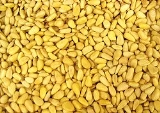
Pinolenic acid
Encyclopedia
Pinolenic acid is a fatty acid
contained in the Korean Pine
nut and the seed
s of other conifers (Taxaceae
). The highest percentage of pinolenic acid is found in Siberian pine nut
s and the oil
produced by them.
delta-5,9,12/18:3) in the biologic literature.
Pinolenic acid is an isomer
of gamma-linolenic acid
(GLA). GLA is an ω-6 essential fatty acid
(EFA) but pinolenic acid is not. However, like the EFAs, it forms biologically active metabolites
in the presence of cyclooxygenase
or lipoxygenase
. These metabolites can partially relieve some of the symptoms of EFA deficiency.
by curbing the appetite.
Pinolenic acid causes the triggering of two hunger suppressants—cholecystokinin
and glucagon-like peptide-1
(GLP-1).
Pinolenic acid may have LDL-lowering properties by enhancing hepatic LDL uptake.
It is sometimes used as a pesticide.
Fatty acid
In chemistry, especially biochemistry, a fatty acid is a carboxylic acid with a long unbranched aliphatic tail , which is either saturated or unsaturated. Most naturally occurring fatty acids have a chain of an even number of carbon atoms, from 4 to 28. Fatty acids are usually derived from...
contained in the Korean Pine
Korean Pine
The tree species Pinus koraiensis is commonly called Korean Pine. It is native to eastern Asia, Korea, Manchuria, far eastern Russia, and central Japan. In the north of its range, it grows at moderate altitudes, typically to , whereas further south, it is a mountain tree, growing at to altitude...
nut and the seed
Seed
A seed is a small embryonic plant enclosed in a covering called the seed coat, usually with some stored food. It is the product of the ripened ovule of gymnosperm and angiosperm plants which occurs after fertilization and some growth within the mother plant...
s of other conifers (Taxaceae
Taxaceae
The family Taxaceae, commonly called the yew family, includes three genera and about 7 to 12 species of coniferous plants, or in other interpretations , six genera and about 30 species....
). The highest percentage of pinolenic acid is found in Siberian pine nut
Pine nut
Pine nuts are the edible seeds of pines . About 20 species of pine produce seeds large enough to be worth harvesting; in other pines the seeds are also edible, but are too small to be of great value as a human food....
s and the oil
Vegetable fats and oils
Vegetable fats and oils are lipid materials derived from plants. Physically, oils are liquid at room temperature, and fats are solid. Chemically, both fats and oils are composed of triglycerides, as contrasted with waxes which lack glycerin in their structure...
produced by them.
Chemistry and biochemistry
Pinolenic acid is formally designated as all-cis-5,9,12-18:3. Some sources also use the term columbinic acid for this substance. But columbinic acid sometimes designates an E-Z isomer (trans,cis,cisdelta-5,9,12/18:3) in the biologic literature.
Pinolenic acid is an isomer
Isomer
In chemistry, isomers are compounds with the same molecular formula but different structural formulas. Isomers do not necessarily share similar properties, unless they also have the same functional groups. There are many different classes of isomers, like stereoisomers, enantiomers, geometrical...
of gamma-linolenic acid
Gamma-Linolenic acid
γ-Linolenic acid is a fatty acid found primarily in vegetable oils...
(GLA). GLA is an ω-6 essential fatty acid
Essential fatty acid
Essential fatty acids, or EFAs, are fatty acids that humans and other animals must ingest because the body requires them for good health but cannot synthesize them...
(EFA) but pinolenic acid is not. However, like the EFAs, it forms biologically active metabolites
Metabolomics
Metabolomics is the scientific study of chemical processes involving metabolites. Specifically, metabolomics is the "systematic study of the unique chemical fingerprints that specific cellular processes leave behind", the study of their small-molecule metabolite profiles...
in the presence of cyclooxygenase
Cyclooxygenase
Cyclooxygenase is an enzyme that is responsible for formation of important biological mediators called prostanoids, including prostaglandins, prostacyclin and thromboxane. Pharmacological inhibition of COX can provide relief from the symptoms of inflammation and pain...
or lipoxygenase
Lipoxygenase
Lipoxygenases are a family of iron-containing enzymes that catalyse the dioxygenation of polyunsaturated fatty acids in lipids containing a cis,cis-1,4- pentadiene structure. It catalyses the following reaction:...
. These metabolites can partially relieve some of the symptoms of EFA deficiency.
Physiology
Recent research has shown its potential use in weight lossWeight loss
Weight loss, in the context of medicine, health or physical fitness, is a reduction of the total body mass, due to a mean loss of fluid, body fat or adipose tissue and/or lean mass, namely bone mineral deposits, muscle, tendon and other connective tissue...
by curbing the appetite.
Pinolenic acid causes the triggering of two hunger suppressants—cholecystokinin
Cholecystokinin
Cholecystokinin is a peptide hormone of the gastrointestinal system responsible for stimulating the digestion of fat and protein...
and glucagon-like peptide-1
Glucagon-like peptide-1
Glucagon-like peptide-1 is derived from the transcription product of the proglucagon gene. The major source of GLP-1 in the body is the intestinal L cell that secretes GLP-1 as a gut hormone. The biologically active forms of GLP-1 are: GLP-1- and GLP-1-NH2...
(GLP-1).
Pinolenic acid may have LDL-lowering properties by enhancing hepatic LDL uptake.
It is sometimes used as a pesticide.

